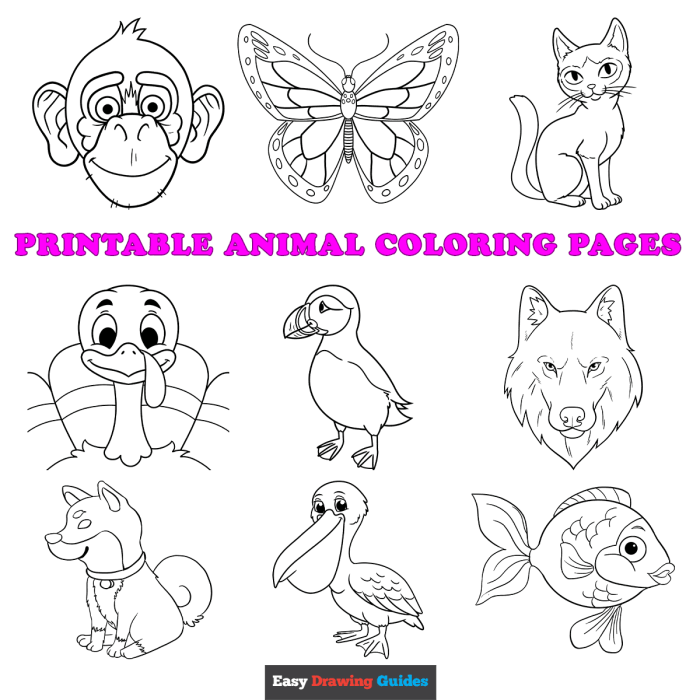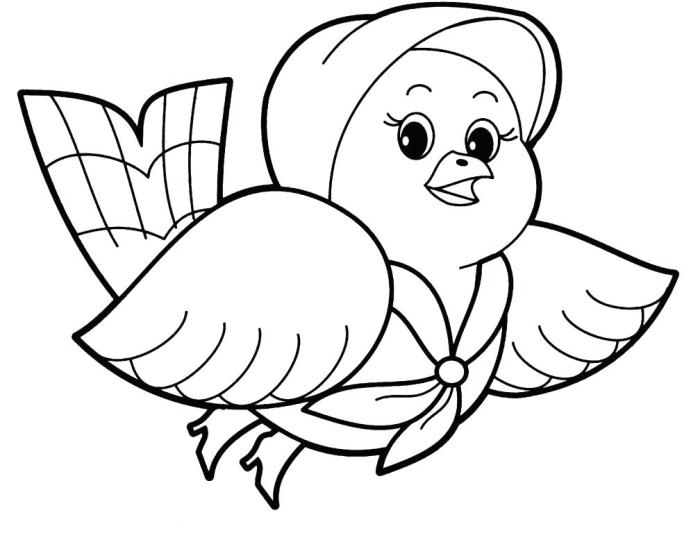Educational Value

Coloring pages animals for kids – Animal coloring pages offer a surprisingly rich educational experience for young children, extending far beyond simple entertainment. The act of coloring itself contributes to crucial developmental milestones, while the subject matter—animals—introduces children to the natural world and fosters a sense of wonder and curiosity. This multifaceted approach makes animal coloring pages a valuable tool in both home and educational settings.Animal coloring pages significantly contribute to a child’s development in several key areas.
The precise movements required for coloring within the lines help develop fine motor skills, hand-eye coordination, and dexterity. This is particularly important for pre-writing skills, laying a foundation for future literacy development. Furthermore, choosing colors, blending shades, and creating unique interpretations fosters creativity and self-expression. Children learn to make choices, experiment with different techniques, and develop their own artistic style.
Finally, the depiction of animals introduces children to diverse species, their appearances, and habitats, stimulating learning about the natural world and expanding their knowledge base.
Coloring pages featuring animals are a fantastic way to engage kids creatively. For a truly wild adventure, consider exploring the incredible diversity of African wildlife with free coloring pages of African animals ; they’re a great resource for expanding your child’s knowledge of animals while having fun. These pages offer a unique opportunity to learn about different species, making the coloring experience both entertaining and educational for young learners.
Fine Motor Skill Development Through Coloring
Coloring within the lines of animal coloring pages requires precise hand movements and coordination between the eyes and hands. This repetitive action strengthens small muscles in the fingers and hands, improving dexterity and control. This enhanced fine motor control is directly transferable to other activities such as writing, drawing, and using utensils. Studies have shown a strong correlation between fine motor skill development in early childhood and later academic success, particularly in areas requiring writing and manipulation of small objects.
For instance, a child struggling to hold a crayon properly might find it challenging to write legibly later on. Animal coloring pages provide a fun and engaging way to address this developmental need.
Creative Expression and Self-Discovery
The act of coloring itself is an avenue for creative expression. Children are not limited to simply replicating the provided image; they can explore different color palettes, experiment with shading techniques, and add their own unique details. This freedom of choice allows them to express their personality and develop their individual artistic style. For example, a child might choose vibrant, bright colors to depict a playful monkey, while another might opt for more subdued tones to represent a serene elephant.
This process of self-expression builds confidence and encourages children to embrace their individuality.
Enhancing the Educational Value of Animal Coloring Pages
To maximize the educational benefits, several strategies can be employed. Pairing coloring pages with factual information about the depicted animals, such as their habitat, diet, or behavior, enriches the learning experience. Engaging children in discussions about the animals they are coloring encourages critical thinking and language development. Furthermore, incorporating activities like creating animal fact files or drawing their own animals based on what they have learned further solidifies their understanding.
Finally, using coloring pages as a reward system for completing other tasks can increase motivation and associate positive feelings with learning.
The Impact of Animal Choice on Learning
The selection of animals depicted on coloring pages directly influences the learning experience. Choosing a variety of animals, including both common and less familiar species, broadens children’s knowledge of the animal kingdom. Depicting animals from different habitats and ecosystems allows children to learn about biodiversity and environmental conservation. For instance, a coloring page featuring a polar bear can spark a conversation about the Arctic and the challenges faced by polar bears due to climate change.
Similarly, a coloring page showcasing a brightly colored tropical bird can introduce children to the diverse ecosystems of rainforests. Carefully curated animal selections can therefore serve as a springboard for broader educational discussions.
Marketing and Sales: Coloring Pages Animals For Kids

The successful marketing and sales of animal coloring pages for kids hinges on understanding the target audience (parents) and leveraging appropriate distribution channels and pricing strategies. Effective marketing campaigns should highlight the educational and entertainment value while addressing parental concerns about screen time and child development.Effective marketing requires a multi-pronged approach encompassing both online and offline strategies, carefully considering the unique characteristics of the product and the target demographic.
The pricing model should be competitive yet reflect the quality and value proposition of the coloring pages.
Primary Sales and Distribution Channels
Online marketplaces like Etsy, Amazon Handmade, and dedicated print-on-demand services offer convenient access to a broad customer base. Physical stores, including bookstores, toy stores, and educational supply shops, provide a tangible experience and opportunity for impulse purchases. Subscription boxes catering to children’s activities or educational materials represent a recurring revenue stream. Finally, a direct-to-consumer website with an e-commerce platform allows for maximum control over branding and customer interaction.
Effective Marketing Strategies Targeting Parents
Marketing efforts should focus on the benefits parents seek: educational value, screen-free entertainment, creative stimulation, and opportunities for bonding. Social media marketing, particularly on platforms like Instagram and Facebook, where parents are highly active, is crucial. Targeted advertising campaigns emphasizing these benefits are effective. Collaborations with parenting bloggers and influencers can significantly boost brand awareness and credibility. Participating in relevant online forums and parenting groups allows for direct engagement with the target audience.
Print advertising in parenting magazines and local community publications can also reach a relevant segment of the market. Email marketing, with newsletters featuring new designs and promotions, can foster customer loyalty and drive repeat purchases.
Pricing Strategies for Animal Coloring Pages
Pricing varies depending on factors such as the number of pages, the quality of the paper, the complexity of the designs, and the presence of additional features like stickers or activity guides. Simple coloring pages with fewer designs can be priced lower, perhaps in the range of $2-$5 per book. More elaborate books with high-quality paper and intricate designs could command higher prices, ranging from $8-$15 or more.
Subscription services often involve a monthly or annual fee, providing ongoing value to customers. Digital downloads can be priced lower than physical copies, reflecting reduced production costs. Bundling multiple coloring books together at a discounted price can also incentivize purchases. Pricing should be competitive with similar products on the market while reflecting the value and quality of the offering.
Sample Marketing Campaign: “Majestic Lions Coloring Book”
This campaign focuses on a coloring book featuring a variety of lion designs, from playful cubs to majestic adults in various settings. The marketing materials emphasize the educational aspect of learning about lions and their habitats while highlighting the calming and creative benefits of coloring. The campaign uses high-quality images showcasing the intricate designs and vibrant colors. Social media posts feature user-generated content of children coloring the pages, fostering a sense of community and engagement.
Targeted advertising on Facebook and Instagram reaches parents interested in wildlife, education, and children’s activities. Collaborations with wildlife conservation organizations add credibility and align the product with a socially responsible cause. The campaign slogan: “Roar into Creativity: Unleash your child’s imagination with our Majestic Lions Coloring Book!” promotes both the fun and educational aspects of the product.
A limited-time offer, such as a discount or bonus sticker sheet, can drive immediate sales.
Illustrations and Imagery

Effective illustrations are crucial for engaging children with animal coloring pages. The style, detail, and line weight all contribute to the overall appeal and ease of use for young colorists. Consideration of positive and negative space, and the strategic use of line thickness, further enhance the visual impact and enjoyment of the activity.
Three Animal Illustration Examples
The following descriptions detail three distinct animal illustrations suitable for coloring pages, highlighting variations in style and complexity.
Illustration 1: A playful cartoon-style squirrel. Line weight is consistently thin (approximately 0.5 pt), creating a delicate and simple Artikel. The style is characterized by exaggerated features – large, expressive eyes, a bushy tail depicted with simplified, flowing lines, and a slightly chubby body. Detail is minimal; the fur texture is suggested rather than meticulously rendered. This style is ideal for younger children.
Illustration 2: A realistic-looking elephant. Line weight varies from 1 pt for the main Artikels to 0.75 pt for finer details like wrinkles on the skin and the texture of the ears. The style aims for anatomical accuracy, showcasing the elephant’s characteristic features with precision. Details include individual toenails, the texture of the trunk, and the subtle curves of the body. This style is appropriate for older children with developing fine motor skills.
Illustration 3: A stylized penguin. Line weight is bold and consistent (approximately 2 pt), creating strong, graphic Artikels. The style is simplified, emphasizing shape and form over minute details. The penguin’s body is depicted with smooth, rounded lines, and its features are reduced to essential elements. This style is highly accessible for a wide age range, requiring less precise coloring.
Lion Cub Illustration
The illustration depicts a lion cub sitting playfully in tall grass. Its expression is one of cheerful curiosity; its large, round eyes are wide open, and its mouth is slightly ajar in a gentle, open-mouthed smile. Its posture is relaxed and inviting, with its paws tucked slightly underneath it. The surrounding environment is rendered with simplified lines, showing tall blades of grass swaying gently in the breeze.
The overall feel is light-hearted and endearing, encouraging children to engage with the coloring process.
Positive and Negative Space, Coloring pages animals for kids
Effective use of positive and negative space is critical in animal coloring page illustrations. Positive space refers to the area occupied by the animal itself, while negative space is the surrounding empty area. A balanced interplay between these two elements is essential for creating a visually appealing and uncluttered design. For instance, a large animal might benefit from more negative space around it to avoid a cramped feel, while a smaller animal might be better suited to a more detailed and busy background.
Strategic use of negative space can also be used to create a sense of depth and movement.
Line Thickness and Visual Interest
Varying line thicknesses adds significant visual interest to animal coloring page illustrations. Thicker lines (1.5 pt – 2 pt) can be used to emphasize key features, such as the Artikel of the animal’s body, creating a strong foundation for the coloring. Thinner lines (0.5 pt – 1 pt) can be used for finer details, such as fur texture or facial features, adding subtle complexity without overwhelming the design.
For example, thicker lines could Artikel a giraffe’s long neck, while thinner lines would detail the pattern of spots. This contrast in line weights guides the eye and creates a more dynamic and engaging image for the child to color.
